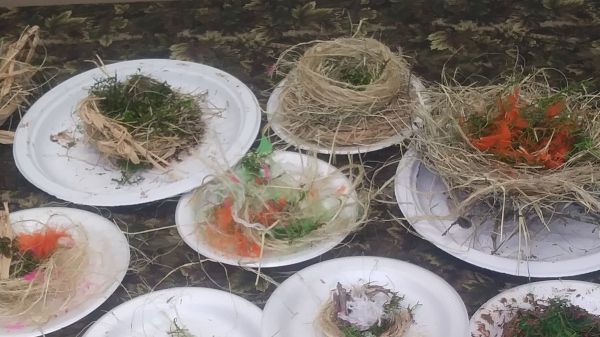E-STEM in the Classroom: Building Bird Nests

Shortly after premiering a new program called Bird Nest Exploration at my nature park, a local STEM lab teacher contacted me. She was just beginning a unit on building bird nests in her lab and asked if I could bring my program to her school for 5 second grade classes. I enthusiastically agreed, and set off with several boxes of nests, showing a variety of building techniques, nest strength and materials. The kids and I examined the nests, talking about what makes a good nest and comparing the properties of different building materials.

After interacting with lots of examples of real bird nests, the students used the Engineering Design Process displayed on the wall of their classroom to build their own nests, testing and revising to perfect their designs.

The bird nest lesson fulfilled a state science standard for second grade. Bringing the nests into the lab allowed the children to touch and examine real objects from nature, an opportunity that is increasingly rare for our youth. Bird nests easily attract attention and spark the imagination. They provide a versatile starting point for a variety of science, engineering and math lessons, as well as being a natural fit for projects employing the Engineering Design Process. This lesson is easily modified for any grade in the pK-12 spectrum and works well as a mixed-age public program in an informal setting.
Have you been contemplating venturing into E-STEM? This program’s simplicity makes it an easy first step your audience is sure to love!


Comments
In reply to 561 by Jeanine Huss
Great question! The students used mostly recycled materials to build their nests. It was what was on hand, and really it helped them think about the what they were learning in the lesson more. They examined the properties of each material for its usefulness in building a good nest without having the short cut of thinking it must be good for nests because they've seen it used in real bird nests.
Great activity. There is also a way to tie this into Leave No Trace if you are planning to use natural objects for the project. Before the project begins, explain a little bit about what Leave No Trace is and why it's OK to touch objets found in nature, but not necessarily OK to keep things that we find in nature. Facilitate the activity as normal and when students are finished with the nest building materials, they can scatter those objects back into the outdoors where they were originally gathered. There is a little fine tuning and flow that you'll need to build into this idea, but it's worked well with young learners encountering Leave No Trace concepts.
This sounds great, I have just one question. What did the students use to create the nests? Did they use natural materials found outdoors or did they incorporate some form of technology? Would love to hear!
Fun Activity! Remember that you need a federal salvage / education permit to collect native bird nests. In some states you will also need a state wildlife salvage permit. Check with local /state parks and wildlife agencies to see if they have nests you can borrow for this activity and don't go collecting on your own without a permit. If you don't have access to legally collected nests, you can always use pictures.
What fun, Lily! We have loads of donated nest and I really like this idea to share them with youth (esp. if it hits standards for the area teachers). Would you mind sharing your lesson outline?